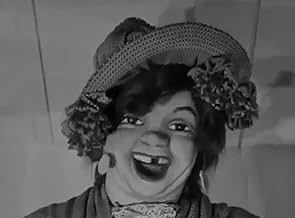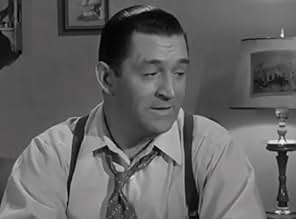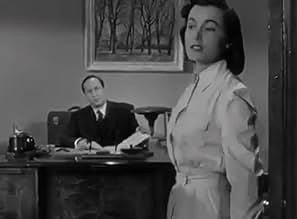IMDb-BEWERTUNG
6,2/10
904
IHRE BEWERTUNG
Füge eine Handlung in deiner Sprache hinzuMany interested parties are after the loot from a factory payroll heist but the mobster who hid it has amnesia after undergoing experimental brain surgery in the prison hospital.Many interested parties are after the loot from a factory payroll heist but the mobster who hid it has amnesia after undergoing experimental brain surgery in the prison hospital.Many interested parties are after the loot from a factory payroll heist but the mobster who hid it has amnesia after undergoing experimental brain surgery in the prison hospital.
Chris Alcaide
- Pursuing Detective
- (Nicht genannt)
Fred Aldrich
- Cop
- (Nicht genannt)
Leonard Bremen
- Guard at Clinic
- (Nicht genannt)
Paul Bryar
- Freddie - Bartender
- (Nicht genannt)
Sayre Dearing
- Patient in Wheelchair at Clinic
- (Nicht genannt)
Frank Fenton
- Detective Driver
- (Nicht genannt)
John Harmon
- Herman
- (Nicht genannt)
Mary Alan Hokanson
- Nurse
- (Nicht genannt)
Shepard Menken
- Interne
- (Nicht genannt)
Howard Negley
- Detective
- (Nicht genannt)
Frank O'Connor
- Gate Guard
- (Nicht genannt)
Empfohlene Bewertungen
I watched most of Man in the Dark without realising it was originally shot in 3D. At first I thought I was watching a lost Fritz Lang classic---extreme closeups, odd points of view, shattering glass---until I remembered the film had been directed by, ahem, Lew Landers. Now nothing against old Lew, he delivered many a fine B picture, but Man in the Dark doesn't look like your typical Columbia programmer. It's black and white take on the 3D process is more noir than you'd expect and it obviously helped to have Floyd Crosby behind the camera. Edmond O'Brien and Audrey Totter are good as always, overcoming a pretty hackneyed script that is the film's major shortcoming. Worth seeing for the dream sequence alone, where O'Brien is pursued by policemen in bumper cars!!
Edmond O'Brien plays a criminal who is paroled to participate in experimental brain surgery which will remove his criminal impulses as well as his memory. The problem is that his former partners want their shares of $130,000 he stole before he went to jail. (Big Plot problem: Why would O'Brien agree to participate in this experiment if he knew he had a bundle waiting for him? Wouldn't he just do his time?) This B-crime drama, too light in tone to qualify as a Film-noir (check out O'Brien in DOA if you want to see some real Film Noir), with its paper-thin characterizations and dated tough guy dialog, would be easily forgotten if not for its status as the first Big Studio picture released in 3-D. Check it out: It beat "House of Wax" to the screens by one day. I just had the good fortune to see an excellent print of the film today at the Maryland Film Festival. (I should say prints, since it was projected by two cameras simultaneously.) The 3-D experience more than compensated for any deficiencies in the script. (In the film's defense, it does move along quite quickly in its effort to entertain.) I have seen many of the classic 3-D films in their natural format, and I found the 3-D in this film fabulous. Just seeing the black & white Columbia logo itself was worth the price of admission. Oddly, however, the intentional 3-D effects, amusing as they could sometimes be, distracted from the overall 3-D experience. I found myself fascinated simply by the illusion of depth in simple conversational scenes with the occasional object in the foreground. If I were flipping through the channels and watched a bit of this film flat on television, I doubt I would linger very long on it, but the excellent 3-D made it a worthwhile theatrical experience. Check it out if you ever get the chance.
Edmond O'Brien played in quite a few film noir pictures. And, interestingly, they all seem to be excellent...even "Man in the Dark" which you would expect to be a bad picture even WITH O'Brien. Why? Because the film was cranked out in only 11 days AND because there were a lot of cheap 3D tricks in the picture...yet it still turned out to be very, very good. So why would the studio do this in 11 days? Apparently, 3D movies were brand new and they wanted to be the first major studio to make a 3D picture....yet, amazingly, the film doesn't seem rushed or second-rate!
When the story begins, a prisoner (O'Brien) is about to undergo some surgery. When he awakens, he has no memory of who he was and is christened 'Steve Rawley' by the doctors. Unfortunately, his old gang doesn't know about the purpose of the surgery--they just know they've got to kidnap him and tell them where he stashed the loot from a robbery. But he really does NOT know where it is nor who he was. His only clues are strange dreams he's been having. Could they point him to the right direction before the gang decides just to kill him and be done with it?
As usual, Edmond O'Brien is great. He's tough, mouthy and just the sort of ugly mug you'd expect in a noir picture. And, having Audrey Totter and Ted de Corsia in supporting roles sure didn't hurt! Overall, a nice viewing experience...even with all the 3D gimmicks and use of rear projection towards the end (which I normally hate because it looks so fake).
When the story begins, a prisoner (O'Brien) is about to undergo some surgery. When he awakens, he has no memory of who he was and is christened 'Steve Rawley' by the doctors. Unfortunately, his old gang doesn't know about the purpose of the surgery--they just know they've got to kidnap him and tell them where he stashed the loot from a robbery. But he really does NOT know where it is nor who he was. His only clues are strange dreams he's been having. Could they point him to the right direction before the gang decides just to kill him and be done with it?
As usual, Edmond O'Brien is great. He's tough, mouthy and just the sort of ugly mug you'd expect in a noir picture. And, having Audrey Totter and Ted de Corsia in supporting roles sure didn't hurt! Overall, a nice viewing experience...even with all the 3D gimmicks and use of rear projection towards the end (which I normally hate because it looks so fake).
Edmond O'Brien has a severe case of retrograde amnesia, but he didn't contract it in the Pacific. He's a robber who got away with $130,000 in a Christmas Eve heist, was convicted and served his time. But he'll get a second chance if he submits to an operation to excise the criminal portion of his brain. Understandably, he's conflicted, and when they move it up from the scheduled day he balks: `I was born on a Monday. I may as well go on one like dirty laundry.' But the operation proves a stunning success, so delicate that it erases all memories of his past life but leaves him with a perfect command of American slang.
But the placid life he leads at the sanitarium pruning hedges and daubing canvases comes to an abrupt halt when he's kidnaped by his old gang, now led by Ted De Corsia. They want the money, which was never recovered; so does an implacable Javert of an insurance investigator. Even his old girlfriend (Audrey Totter) sees him only as a ticket to the high life, until she falls for the new, improved O'Brien and renounces her grasping ways. (The often ill-used Totter shines here, especially on a martini bender when she asks the bartender, `Oh, Fred, what do you do when you hate yourself?')
Odd clues begin to surface from O'Brien's troubled nightmares, however, leading him and Totter (with the rest of the cast plus the police in pursuit) to claim a parcel left at an amusement park. And this is the big set-piece of the movie, originally released in 3-D. Cars come whooshing around the curves and down the dips of a roller coaster while pitched battles are being fought on the tracks. Watching these 3-D movies now is like drinking soda that's gone flat: All the ingredients are there but the sparkle's gone. But in their endearingly gimmicky way, they evoke their era, as do the flats equipped with party lines and furnished with lampshades bearing reproductions of paintings. Man in the Dark's too short, and needs an extra layer of complexity. But there's still a bit of fizz left in it.
But the placid life he leads at the sanitarium pruning hedges and daubing canvases comes to an abrupt halt when he's kidnaped by his old gang, now led by Ted De Corsia. They want the money, which was never recovered; so does an implacable Javert of an insurance investigator. Even his old girlfriend (Audrey Totter) sees him only as a ticket to the high life, until she falls for the new, improved O'Brien and renounces her grasping ways. (The often ill-used Totter shines here, especially on a martini bender when she asks the bartender, `Oh, Fred, what do you do when you hate yourself?')
Odd clues begin to surface from O'Brien's troubled nightmares, however, leading him and Totter (with the rest of the cast plus the police in pursuit) to claim a parcel left at an amusement park. And this is the big set-piece of the movie, originally released in 3-D. Cars come whooshing around the curves and down the dips of a roller coaster while pitched battles are being fought on the tracks. Watching these 3-D movies now is like drinking soda that's gone flat: All the ingredients are there but the sparkle's gone. But in their endearingly gimmicky way, they evoke their era, as do the flats equipped with party lines and furnished with lampshades bearing reproductions of paintings. Man in the Dark's too short, and needs an extra layer of complexity. But there's still a bit of fizz left in it.
Here's an example of a routine thriller that could have been so much better if the script hadn't been so banal. Unfortunately, nothing really riveting happens until the last twenty minutes when the amnesiac victim enters an amusement park with some startling results.
It's the final chase scene that make the film come to life, but by that time (and even though the running time is brief), many a viewer will be turned off by the pedestrian script and the average performances.
Even old pros like Edmond O'Brien and Audrey Totter look as though they know the script is the problem. Totter, minus her usually scrappy dialog has a colorless role. She plays it straight but makes almost no impression as the woman who wants her boyfriend to amend his old ways after he finds the missing loot that the villains are chasing him for.
It was originally intended to be shown in 3D, and this is obvious from some of the gimmicky B&W photography for the carnival scene. Still, the low-budget aspect of the whole thing is apparent from the start and the final impression is of a quickie B-film unworthy of O'Brien and Totter.
Ted De Corsia has his usual tough guy role as the punk who likes to slam O'Brien around but even he is handicapped by the hackneyed tough guy dialog. Lew Landers directs the story without any distinction until the final scenes at the amusement park.
It's the final chase scene that make the film come to life, but by that time (and even though the running time is brief), many a viewer will be turned off by the pedestrian script and the average performances.
Even old pros like Edmond O'Brien and Audrey Totter look as though they know the script is the problem. Totter, minus her usually scrappy dialog has a colorless role. She plays it straight but makes almost no impression as the woman who wants her boyfriend to amend his old ways after he finds the missing loot that the villains are chasing him for.
It was originally intended to be shown in 3D, and this is obvious from some of the gimmicky B&W photography for the carnival scene. Still, the low-budget aspect of the whole thing is apparent from the start and the final impression is of a quickie B-film unworthy of O'Brien and Totter.
Ted De Corsia has his usual tough guy role as the punk who likes to slam O'Brien around but even he is handicapped by the hackneyed tough guy dialog. Lew Landers directs the story without any distinction until the final scenes at the amusement park.
Wusstest du schon
- WissenswertesThe first 3-D feature ever released by a major American studio. Das Kabinett des Professor Bondi (1953) went into production first, but Columbia rushed "Man in the Dark" - shooting it in a mere 11 days - to get it into theaters just days before "Wax" opened. (Bwana, der Teufel (1952) preceded both of them, but United Artists was not considered a major studio in the early 1950s.)
- PatzerDuring the chase when Steve is abducted, one of the crooks leans out of the car and fires nine shots at the cops from a six-shot revolver.
- Zitate
[first lines]
Cop: You get prettier every day.
Nurse Receptionist: Tell me about the beauty contest you won.
- Alternative VersionenOriginally released in 3D, in prints that were sepia-toned.
- VerbindungenFeatured in TJ and the All Night Theatre: The Man Who Lived Twice (1979)
Top-Auswahl
Melde dich zum Bewerten an und greife auf die Watchlist für personalisierte Empfehlungen zu.
Details
- Laufzeit1 Stunde 10 Minuten
- Seitenverhältnis
- 1.37 : 1
Zu dieser Seite beitragen
Bearbeitung vorschlagen oder fehlenden Inhalt hinzufügen

Oberste Lücke
By what name was Der Mann im Dunkel (1953) officially released in India in English?
Antwort


































